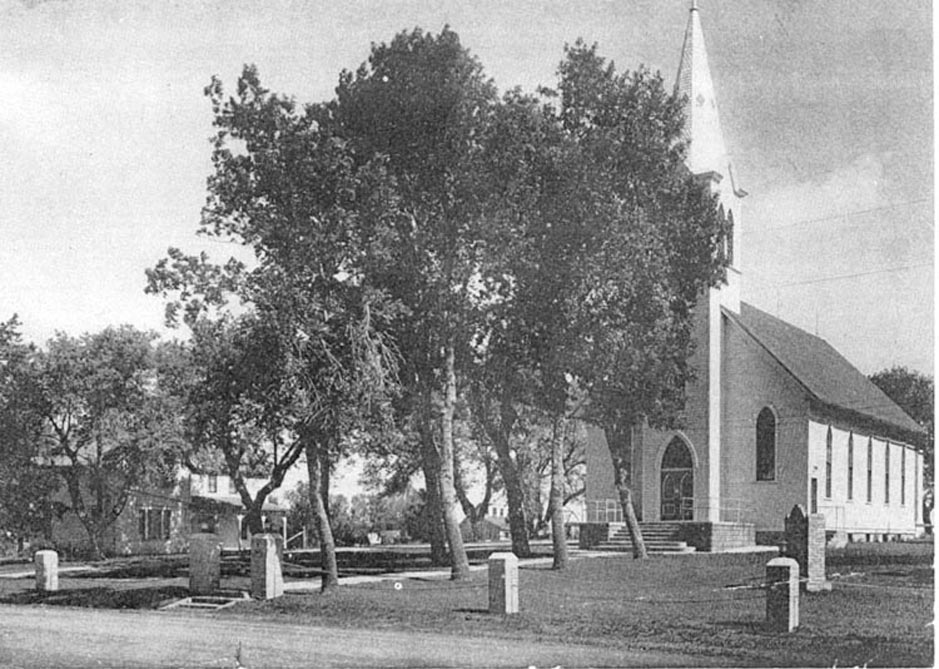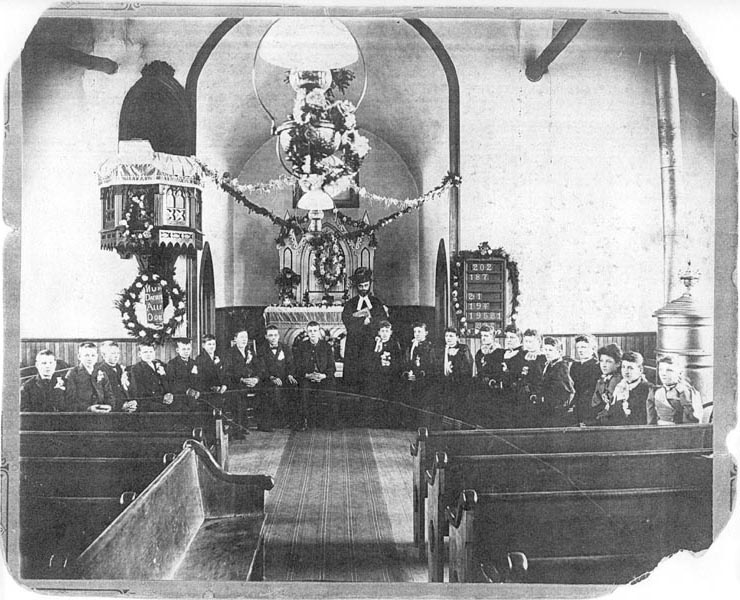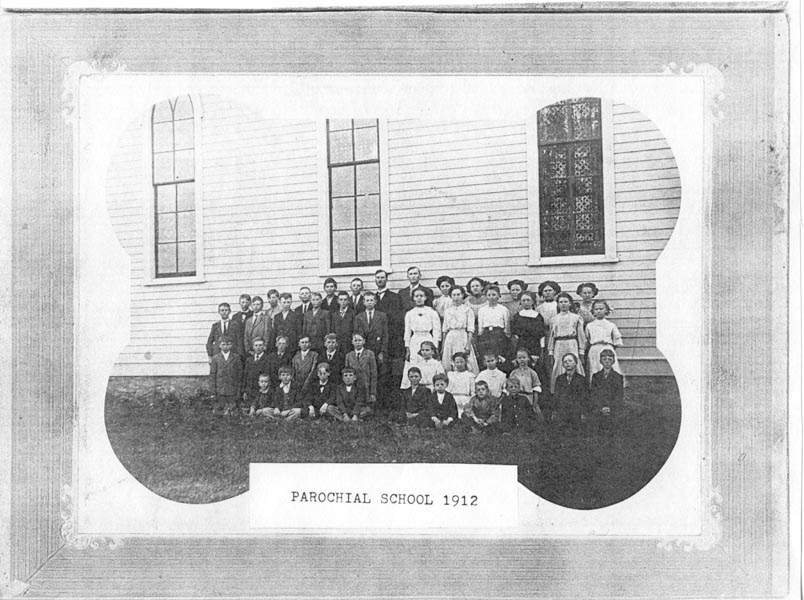Trinity Lutheran Church
Grant Township, Ida County, Iowa
1870 - 1969 History
The Trinity Lutheran Church in Grant Township of Ida County was the home church for many Crawford County residents north of present day Schleswig. Thus, we felt it appropriate to include the history of this church which served many Crawford residents for almost 100 years.
On September 14, 1969, Trinity Lutheran Church, Grant Township, Ida County, held its last service. This closed 89 years of continuous service to the community. The congregation voted to close on the previous Monday night due to extensive wind damage to the church by a tornado on July 28. The vote to close was also influenced by the declining rural population which seriously hampered any growth in membership. The membership decided that it would be better stewardship to join neighboring congregations than to rebuild.
Church Organized in 1870 in Crawford County
Trinity Lutheran Church was organized on September 19, 1870 at the Westerly School of Otter Creek Twp., Crawford County, under the direction of the Rev. Gottlieb Harr of Denison. The Rev. Haar then suggested that the congregation request the services of the Rev. Gossweiler of St. Paul, Hanover Twp. After 16 months of service, he accepted a call and left. The congregation then sent a call to Rev. Harr and he accepted. During his 2 years of ministry, he opened a mission station in Ida Grove, the present location of the congregation was purchased, and a parochial school was started. Upon his departure, a call was extended to the Rev. Hermann who was installed into his office August 9, 1885.
The following spring, the congregation changed its name from "First German Trinity Evangelical Lutheran Church" to "Trinity Evangelical Lutheran Church."
A House of Worship is Built in Ida County
During Rev. Hermann's ministry, it became apparent that there was a need for a more adequate place of worship, so on June 16, 1889 the congregation voted to build the structure.
The cornerstone was laid on August 18 of the same year and the church was dedicated on November 24, 1889. The church was built by the contractors, G. Woock and Son for the sum of $3,293.00.
The Rev. Hermann accepted a call in August of 1892, so the congregation extended another call to The Rev. Schug who accepted and was installed on October 16 of the same year. It was during Rev. Schug's stay that the congregation built its first parochial school at a cost of $340,000. Prior to this, the school was conducted in the pastor's home.
Confirmation Class of 1894 - Pastor Schug
Carl Wofer (Wolfer), W. Hugo Wigand, Carl Gustav Ludwig, Wilhelm Rehse, Carl Rehse, Asmus Hollander, Willie Abbe, Wilhelm H. Streck, Johannes Lohse
Louise Wolfer, Lina Lorse, Emma Kuehl, Julia Kuehl, Meta Hollander, Johanna Mosees, Martha Schug, Ida Burk, Anna Kramer, Catherine Petersen, Fredericka Petersen
Parochial school children in 1912
During Rev Schug's ministry, the congregation had no musical instruments but had a band to lead in the singing. It was not until the Rev. Vonder Au prevailed upon the congregation that an organ was purchased. Mr. Albert Ernst became the first organist and served in that capacity until 1931 when his daughter Helen, Mrs. Walter Streck, took over and served continuously until the church closed.
Following Rev. Vonder Au, The Rev. Amstein accepted a call and was installed in the spring of 1904. He served until October 1911. During his stay, much was done to improve the church site, walks were laid, an orchard was started, a cistern was dug, and water pipes laid.
The Rev. Schwenk became Trinity's pastor in 1911 with the understanding that he start a mission congregation in Schleswig. Under his guidance, Immanuel Lutheran Church was organized in the fall of 1912. Rev. Schwenk stayed until his retirement on November 1, 1931.
The Rev. C. W. Schmidt answered Trinity's call and was installed as pastor in January 1932. During Rev. Schmidt's ministry, German services were dropped. Rev. Schmidt received a call to Zion Denison and was released on July 18, 1937.
Trinity extended a call to The Rev. Alfred Christiansen and he was installed into his office on September 19, 1937. During his ministry, a number of projects were carried out. The church was wired for electricity in 1939, and the 60th Anniversary was observed on September 15, 1940. The teacherage was sold and new pews were purchased for the church and dedicated in October of 1940, the parsonage was insulated, and the cemetery was placed under perpetual care, each lot holder being assessed $50. In November, 1944, Rev. Christiansen accepted a call to Rock Rapids and was given a peaceful release.
Early the following year, The Rev. Norman Rothe was installed. During his short ministry, it was decided to have the Lord's Supper offered monthly and on Maundy Thursday. It was also decided to put a full basement under the church and install an oil burning furnace with a blower. This project was completed during the vacancy following Rev. Rothe's acceptance of a call to Van Horne, Iowa. This vacancy was Trinity's longest, extending some fifteen months. The Rev. L. S. Winters of Stockholm church, St. John, served Trinity during this time.
The Rev. M. H. Leedahl answered Trinity's call and was installed on April 3, 1947. The church continued to show a willingness to progress by installing a new water pressure system for the parsonage and church, by purchasing a new Hammond organ, by making over a room in the parsonage for the pastor's study, and installing a new bathroom. The same year, 1949, the parochial school was torn down.
During Rev. Leedahl's ministry, visual aid equipment was purchased for the Sunday school and a tape recorder for the shut-ins. The Walther League filled and leveled the church grounds, built the brick bulletin board, the fence in front of the church, and new tables and chairs were purchased for the church basement.
In 1955, the church was readied for its 75th Anniversary. The church was redecorated both upstairs and down, the arch of the chancel remodeled, new hymn boards made, new carpeting purchased by the Fellowship Club, a second entrance was put in for the basement and the church kitchen was remodeled. The same summer, the parsonage was repainted, the entrance remodeled, and a new foundation was put under it. The congregation moved in July of 1956 to share in the radio ministry of the Denison Zone through its broadcast on Sunday afternoon over K.D.S.N. at a cost of $30 per year.
It was during Rev. Leedahl's ministry that Trinity and St. Paul Hanover Twp., formed a dual parish. Rev. Leedahl began his ministry at St. Paul as the vacancy pastor upon the peaceful release of the Rev. Zuberbier in November of 1956. On January 5, 1958, arrangements were made for the forming of the dual parish, and Rev. Leedahl continued his ministry in the dual parish until October 1961.
The dual parish was then vacant for 9 1/2 months when on July 15, 1962, the Rev. Clarence Pannier, a candidate from Concordia Theological Seminary, Springfield, Illinois, was installed as pastor. During his ministry, the church adopted a new constitution, and the church tower was lowered and an illuminated cross was erected on the roof of the tower. Rev Pannier accepted a call to Urbandale, Iowa, in August 1965.
The parish was vacant one year following Rev. Pannier's peaceful release. During this time, it was served by Rev. Kempfert of Galva, Iowa. The Rev. John C. McKiness was installed in September of 1966. Rev. McKiness was also a candidate from Concordia Theological Seminary, Springfield, Illinois. During his ministry, Easter Sunrise Services were held for the first time with breakfast being served by the Walther League, and all male members over 21 were made voting members.
During the 89 years of service, 1682 souls were baptized, 827 confirmed, 388 marriages were performed, and 239 souls were laid to rest. The three congregations that were begun by her mission efforts, St. Paul of Ida Grove, Immanuel of Schleswig, and St. John of Battle Creek, continue in her memory.
We thank Conley Wolterman who submitted the history and pictures for these pages.





